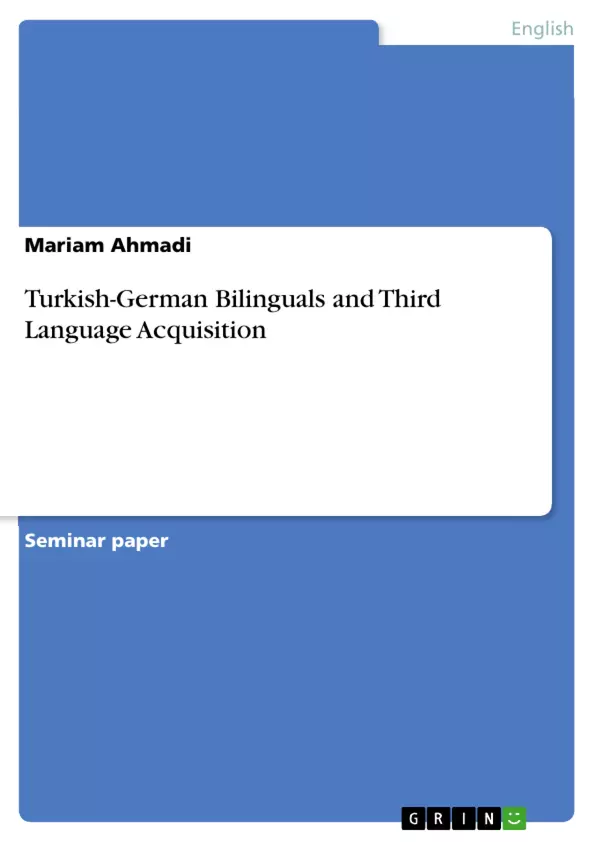This paper deals with the process of third language acquisition by Turkish immigrants in Germany. This process is unique and distinct from their first and second language acquisition, as it is influenced by first and second language acquisition.
Cultural diversity in different societies around the world, in the 21st century, places a great emphasis on the value of language acquisition. Whether it is in business, politics or other international interactions, and further aspects of life, in particular education, language acquisition has become more and more important.
As a result, bilingualism is seen as a norm rather than an exception in many societies around the globe. Although considered fairly recent, linguistics have studied the acquisition of a first language by infants and second language acquisition in children and adults with varying approaches in the past decades. However, people are not only increasingly exposed to numerous languages in multilingual settings but they are also learning them. This is ascribed to the movement of people from one society to another resulting in an increased contact with different cultures.
Due to that fact, researchers have begun to put an emphasis on studies about multilingualism and the distinct acquisition of languages past a second non-native language. While many researchers classified any non-native language acquisition as second language acquisition in the past, recent studies discuss the phenomenon of third language acquisition.
In this day and age it has become common that migrants who are proficient in their native language and have moved to or are born in a multicultural country will not only learn the official language of that same country but also an additional foreign language. Because of this growing phenomenon bilingualism and its effects on third language acquisition have also gained more attention by researchers in linguistic studies.
According to the Federal Statistical Office of Germany and a microcensus which has been conducted in the year 2013, 16.5 million out of the total population of roughly 81 million people in Germany had a migrant background. The largest ethnic group of immigrants, who either migrated to Germany or were born in Germany as second generation immigrants, is comprised of Turks. On this account language acquisition of Turks living in multicultural Germany and their integration in terms of language is significant to the study of third language acquisition.
Inhaltsverzeichnis (Table of Contents)
- Introduction
- 1. Turkish Immigrants in Germany
- 2. Review of Literature
- 3. Third Language Acquisition in Turkish-German Bilinguals
- 3.1. Analysis of Written Language
- 3.2 Analysis of Spoken Language
- Conclusion
- References
Zielsetzung und Themenschwerpunkte (Objectives and Key Themes)
The paper aims to explore the unique process of third language acquisition in Turkish-German bilinguals, examining how their first and second language experiences influence their learning of a third language, primarily English. The research focuses on the syntactic aspects of third language acquisition, analyzing how Turkish and German influence English word order in bilingual learners.
- Third language acquisition in Turkish-German bilinguals
- Influence of L1 (Turkish) and L2 (German) on L3 (English) acquisition
- Syntactic transfer and interference in third language learning
- Analysis of written and spoken English production in Turkish-German bilinguals
- Comparative study of bilingual and monolingual English acquisition
Zusammenfassung der Kapitel (Chapter Summaries)
- Introduction: The chapter introduces the increasing importance of language acquisition in a globalized world and highlights the growing significance of multilingualism. It emphasizes the shift in focus from second language acquisition to third language acquisition, particularly in the context of migrant populations. The specific case of Turkish immigrants in Germany, as the largest ethnic group with a migrant background, is presented as a crucial area for studying third language acquisition.
- 1. Turkish Immigrants in Germany: This chapter provides historical context regarding Turkish immigration to Germany, tracing their arrival in the 1970s for temporary work. The chapter explores the process of language acquisition in Turkish immigrants, from their initial mono-lingualism in Turkish to the acquisition of German as a second language (L2) for integration into German society and education. It emphasizes the subsequent exposure to English as a third language (L3) within the German educational system.
- 2. Review of Literature: This chapter delves into existing literature concerning third language acquisition, drawing parallels with the study conducted by Şimşek. It emphasizes the importance of distinguishing between second and third language acquisition, acknowledging the specific challenges and unique characteristics of L3 acquisition. The chapter also discusses the significant role of L1 and L2 in shaping the third language learning experience.
- 3. Third Language Acquisition in Turkish-German Bilinguals: This chapter focuses on the core analysis of third language acquisition in Turkish-German bilinguals. It delves into the influence of Turkish and German on the acquisition of English, exploring the syntactic aspects of language transfer and interference. The chapter may include specific examples of written and spoken language production from the participants in the study, providing insights into the learning process.
Schlüsselwörter (Keywords)
This research focuses on third language acquisition, specifically in the context of Turkish-German bilinguals. The study examines the influence of L1 (Turkish) and L2 (German) on L3 (English) acquisition, highlighting the unique characteristics of third language learning. The study utilizes a corpus of written and spoken language data to analyze syntactic transfer and interference, providing insights into the challenges and strategies involved in acquiring a third language in a bilingual context.
- Quote paper
- Mariam Ahmadi (Author), 2015, Turkish-German Bilinguals and Third Language Acquisition, Munich, GRIN Verlag, https://www.grin.com/document/309160



